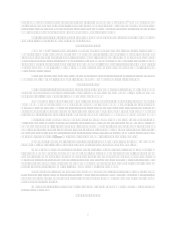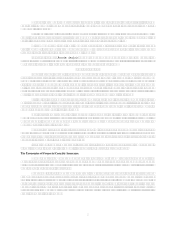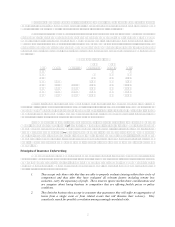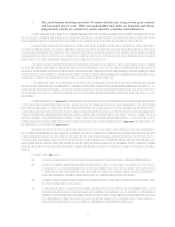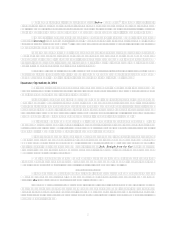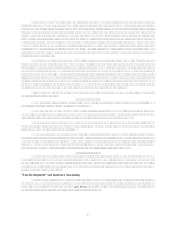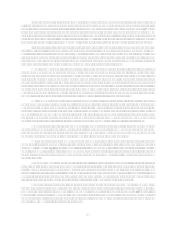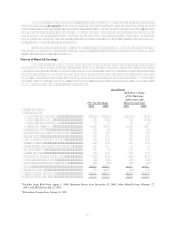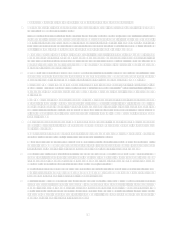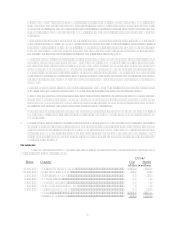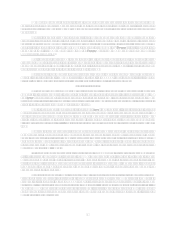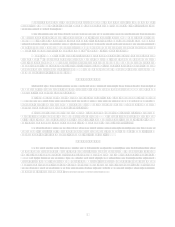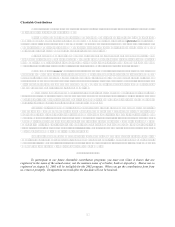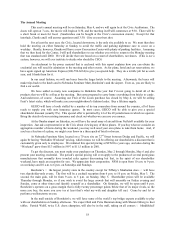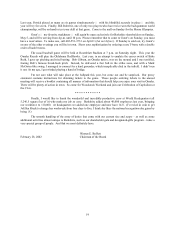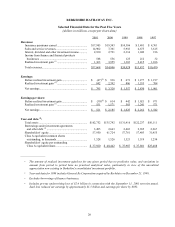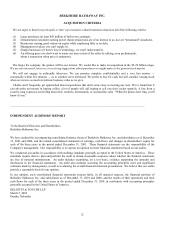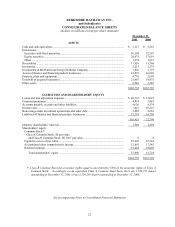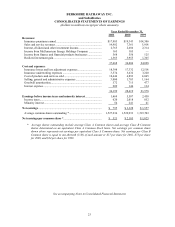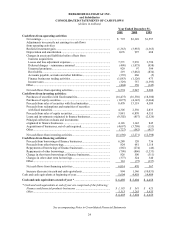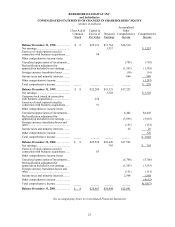Berkshire Hathaway 2001 Annual Report Download - page 16
Download and view the complete annual report
Please find page 16 of the 2001 Berkshire Hathaway annual report below. You can navigate through the pages in the report by either clicking on the pages listed below, or by using the keyword search tool below to find specific information within the annual report.
15
We made few changes in our portfolio during 2001. As a group, our larger holdings have performed
poorly in the last few years, some because of disappointing operating results. Charlie and I still like the basic
businesses of all the companies we own. But we do not believe Berkshires equity holdings as a group are
undervalued.
Our restrained enthusiasm for these securities is matched by decidedly lukewarm feelings about the
prospects for stocks in general over the next decade or so. I expressed my views about equity returns in a speech I
gave at an Allen and Company meeting in July (which was a follow-up to a similar presentation I had made two
years earlier) and an edited version of my comments appeared in a December 10th Fortune article. Im enclosing a
copy of that article. You can also view the Fortune version of my 1999 talk at our website
www.berkshirehathaway.com.
Charlie and I believe that American business will do fine over time but think that todays equity prices
presage only moderate returns for investors. The market outperformed business for a very long period, and that
phenomenon had to end. A market that no more than parallels business progress, however, is likely to leave many
investors disappointed, particularly those relatively new to the game.
Heres one for those who enjoy an odd coincidence: The Great Bubble ended on March 10, 2000 (though
we didnt realize that fact until some months later). On that day, the NASDAQ (recently 1,731) hit its all-time high
of 5,132. That same day, Berkshire shares traded at $40,800, their lowest price since mid-1997.
* * * * * * * * * * * *
During 2001, we were somewhat more active than usual in junk bonds. These are not, we should
emphasize, suitable investments for the general public, because too often these securities live up to their name. We
have never purchased a newly-issued junk bond, which is the only kind most investors are urged to buy. When
losses occur in this field, furthermore, they are often disastrous: Many issues end up at a small fraction of their
original offering price and some become entirely worthless.
Despite these dangers, we periodically find a few a very few junk securities that are interesting to us.
And, so far, our 50-year experience in distressed debt has proven rewarding. In our 1984 annual report, we
described our purchases of Washington Public Power System bonds when that issuer fell into disrepute. Weve
also, over the years, stepped into other apparent calamities such as Chrysler Financial, Texaco and RJR Nabisco
all of which returned to grace. Still, if we stay active in junk bonds, you can expect us to have losses from time to
time.
Occasionally, a purchase of distressed bonds leads us into something bigger. Early in the Fruit of the
Loom bankruptcy, we purchased the companys public and bank debt at about 50% of face value. This was an
unusual bankruptcy in that interest payments on senior debt were continued without interruption, which meant we
earned about a 15% current return. Our holdings grew to 10% of Fruits senior debt, which will probably end up
returning us about 70% of face value. Through this investment, we indirectly reduced our purchase price for the
whole company by a small amount.
In late 2000, we began purchasing the obligations of FINOVA Group, a troubled finance company, and
that, too, led to our making a major transaction. FINOVA then had about $11 billion of debt outstanding, of which
we purchased 13% at about two-thirds of face value. We expected the company to go into bankruptcy, but believed
that liquidation of its assets would produce a payoff for creditors that would be well above our cost. As default
loomed in early 2001, we joined forces with Leucadia National Corporation to present the company with a
prepackaged plan for bankruptcy.
The plan as subsequently modified (and Im simplifying here) provided that creditors would be paid 70%
of face value (along with full interest) and that they would receive a newly-issued 7½% note for the 30% of their
claims not satisfied by cash. To fund FINOVAs 70% distribution, Leucadia and Berkshire formed a jointly-owned
entity mellifluently christened Berkadia that borrowed $5.6 billion through FleetBoston and, in turn, re-lent this
sum to FINOVA, concurrently obtaining a priority claim on its assets. Berkshire guaranteed 90% of the Berkadia
borrowing and also has a secondary guarantee on the 10% for which Leucadia has primary responsibility. (Did I
mention that I am simplifying?).


